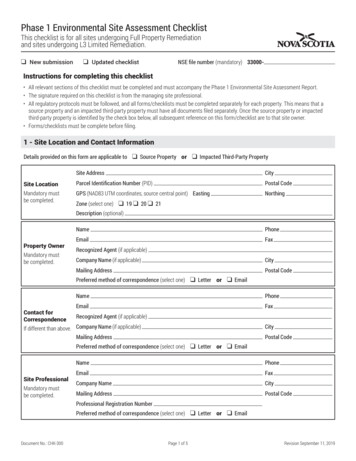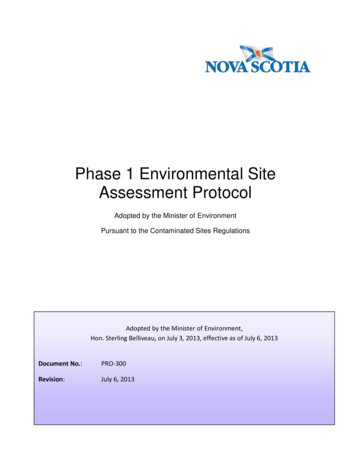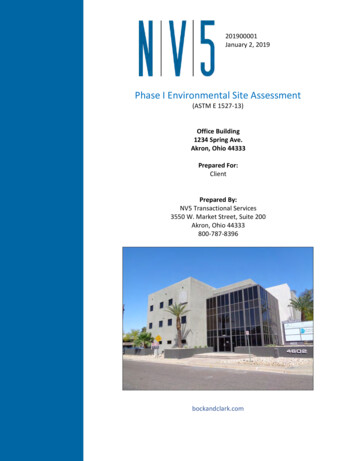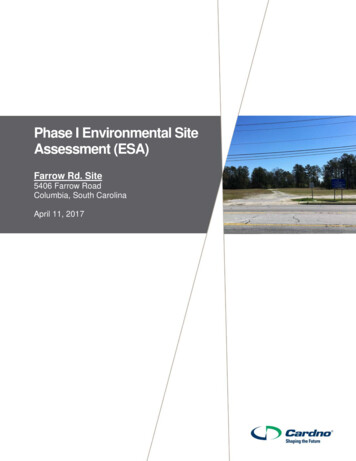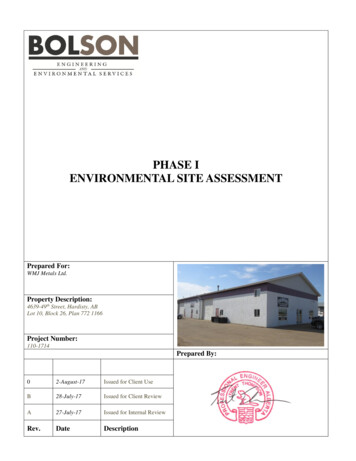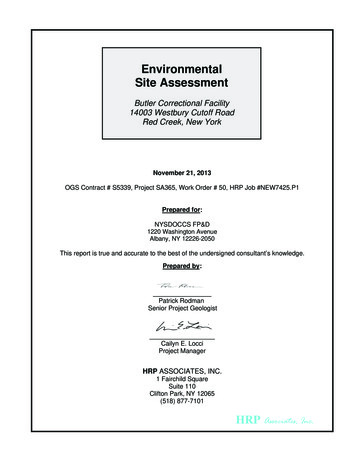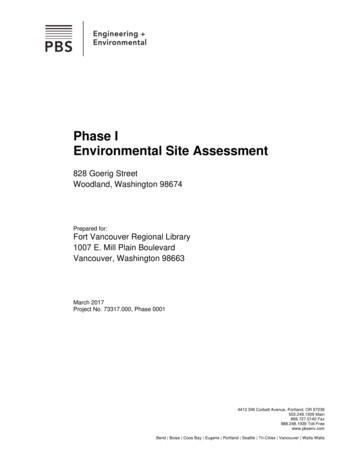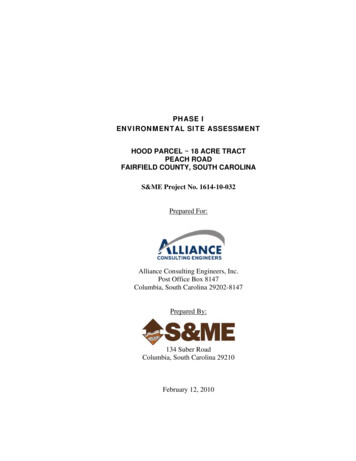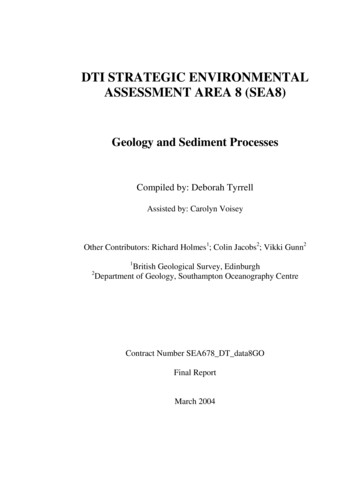
Transcription
DTI STRATEGIC ENVIRONMENTALASSESSMENT AREA 8 (SEA8)Geology and Sediment ProcessesCompiled by: Deborah TyrrellAssisted by: Carolyn VoiseyOther Contributors: Richard Holmes1; Colin Jacobs2; Vikki Gunn212British Geological Survey, EdinburghDepartment of Geology, Southampton Oceanography CentreContract Number SEA678 DT data8GOFinal ReportMarch 2004
SEA8 Geology and Sediment ProcessesAcknowledgementsIn addition to the authors, many scientists and workers in the marine industrycontributed references to the database and their contributions are gratefullyacknowledged.Table of ContentsAcknowledgements .iTable of Contents .iList of Appendices.iList of Tables .iiList of Figures.ii1Introduction.32Geological Processes .43Methodology .84Sources of Metadata .104.1Principal Contributors . 104.1General Web Searches. 134.2Addresses of Relevant Contacts and Organisations . 165References.176Appendices.19List of AppendicesAppendix 1 Keywords used in searching the bibliographic databases forSEA6, SEA7, and SEA8 by BGS and CEFASiFinal Report 15/03/2004
SEA8 Geology and Sediment ProcessesAppendix 2 Index of Geological Maps held by Department of Geology,Southampton Oceanography CentreAppendix 3 BGS MapsMap 3a.Seabed Sample Sites with Particle Size Analysis (map supplied by BGS,data held at BGS)Map 3b.Area of SEA8 covered with DigBath 250k 10m isobaths Analysis (mapsupplied by BGS, data held at BGS)Map 3c.Wells that occur within SEA8 (map supplied by BGS, data held at BGS)Map 3d.Area of SEA8 covered with modified Folk seabed sediment class scheme(map supplied by BGS, data held at BGS)Appendix 4 Endnote fileList of TablesTable 1List of Keywords for literature searchTable 2BOSCOR Results of lat long searchList of FiguresFigure 1Strategic Environmental Assessment AreasiiFinal Report 15/03/2004
SEA8 Geology and Sediment Processes1 IntroductionThis report describes work commissioned by the Department of Trade and Industry(DTI) to prepare an inventory of geology and sediment process metadata for theStrategic Environmental Assessment area 8 (SEA8) in terms of data type, location,quality and availability.The SEA8 region lies between 48 to 52 N and 2 E to 10 W and is presented in Figure1. The area includes the DTI UK Continental Shelf Designated Area from Doverthrough the English Channel to the edge of the continental shelf in the Celtic Sea; thesouthern Irish Sea south of Milford Haven; and the Bristol Channel.26 W24 W22 W20 W18 W16 W14 W12 W10 W8 W6 W4 W2 W0 2 E4 E6 E60 SEA1S EA 458 SEA7S EA 256 SEA 5S EA 354 SE A 6S EA 252 50 S EA 848 Figure 1 Strategic Environmental Assessment Areas3Final Report 15/03/2004
SEA8 Geology and Sediment ProcessesIn accordance with the scope of work the report includes: A description of the study area with a synopsis of the geology and recentsedimentary processes; A listing of international, national and local organisations and contacts who areactive in the subject area or hold information and associated initiatives and datasets. The meta-data inventory, comprising a comprehensive list of references andother sources of information including:i.whether published (white and grey), unpublished, public domain, privateetc.ii.notes and graphics showing spatial and temporal extent;iii.format (book chapter, paper, dataset etc);iv.location;v.accessibility.The main body of the inventory was compiled in June 2003. The database has beenproduced in an Endnote database which contains 1185 entries and is provided oncompact disk in Appendix 4.2 Geological ProcessesThis account is mostly based on a review of the BGS United Kingdom regional offshoregeological reports. These are highlighted by bold print in the references in Section5.The reports contain a comprehensive list of references that are not repeated in thefollowing text.The SEA 8 area encompasses the coastlines and continental shelf including the CelticSea, Bristol Channel, Severn Estuary, and parts of the English Channel and Dover Strait(Figure1).The mainland British Isles and the modern submarine continental shelf connecting theBritish Isles to continental Europe have been cyclically exposed as land and theninundated by the sea since at least 25million years ago. Historical coastline shifts haveoccurred with large-scale (more than 500m) vertical movements of the earth’s crust, thelatest around 5 million years ago (Japsen, 1997). On these were imprinted the global4Final Report 15/03/2004
SEA8 Geology and Sediment Processessea level changes that originated from the periodical changes of polar ice volumes.Post-dating approximately 760,000 years ago there was a shift to overall larger polar icevolumes (Funnel, 1995). During these times large-scale glaciations were nucleated, theglaciations were relatively stable, and the regional ice sheets extended to encompasslarge areas of the northern and middle British mainland and offshore areas. This periodincluded 7 major glacial periods that were approximately 80,000 to 120,000 years long.These were followed by interglacial periods of approximately 10,000 to 15,000 yearsduration (Raymo, 1997). During the maximum of the glacial period, approximately21,000 to 17,000 years ago, sea level in SEA8 was possibly 135m below present(Boussey et al, 1976) and an ice sheet may have surged from the direction of the CelticSea as far south as the Scilly Isles. By the early part of the present interglacial period,approximately 8,300 years ago, the sea had risen again to inundate most of SEA8 and afully marine connection had been re-established between the North Sea and the EnglishChannel (Jelgersma, 1979). During and between the major glacial and interglacialperiods there were other significant periodical climate and sea level changes of 1,000 to3,000, sometimes 5,000 years or more average periodicity (e.g. Clapperton, 1997).During these periods, sea level fluctuated over a range of less than 10m to possibly 50mor more. In this context a relatively unchanged sealevel over approximately the last4,000 years is consistent with the range of sea level variation that may be expected fromthe historical records. A longer-term perspective is that the coastal and seabedtopography and the modern seabed sediment compositions have evolved under theinfluence of profoundly different processes in relatively short periods of geologicaltime. As a result, the seabed topography and seabed sediment composition show somefeatures that have been inherited from previous environments and processes and otherfeatures that are characteristic of modern environments and submarine processes. Forexample, sandy and gravelly seabed sediments on the open continental shelf aretypically reworked from solid rock, silica-rich glacial and fluvial sediments but themodern marine sediments with these constituents are typically mixed with 5 to 20weight % or more shell carbonate debris in the sand fraction.The coast and adjacent continental shelf extending from the southern St George’sChannel to the Scilly Isles, but excluding the English Channel, were probably connectedto the land by a regional ice sheet during the last glaciation. Processes of sub-iceerosion associated with meltwater resulted in the transfer of large volumes of glacialoutwash to the ice sheet margin. After the ice sheet retreated the glacial outwash5Final Report 15/03/2004
SEA8 Geology and Sediment Processessediments were reworked and were probably a significant source for the silty andmuddy modern seabed sediments found in the western SEA8.The effect of erosion and sediment transport by waves in non-storm conditions ismainly confined to a zone to just above the high water mark to about 15m below lowwater. The rates of historical and modern coastal, near-shore and open shelf seabederosion have varied greatly. The hardest and oldest rocks (more than approximately 290million years old), for example, around Devon and Cornwall, are some of the leastsusceptible to erosion by waves and tidal currents. Conversely, most modern coastalinstability and the areas with increased susceptibility of the seabed to wave and tidalerosion occur where the outcrops of the softer and younger rocks (less thanapproximately 65 million years old) cross the modern coastlines. Such localities, forexample, occur between Portsmouth and Bournemouth, and on the northern margin ofthe Isle of Wight. In these areas the modern coastal erosion locally exceeds severalmetres per year and significant volumes of reworked sediments have been transportedthen deposited offshore, sometimes into relatively protected embayments with typicallysandy and muddy seabed sediments. The largest embayments are in the Severn Estuary,which also contains the largest area of inter-tidal flats and where there is significantsediment input into the estuary from the Severn River.Seabed bedforms can be broadly classified into immobile and mobile types and havebeen systematically mapped over the whole of SEA8. Immobile bedforms includeoutcrops of rock, former (drowned) coastlines and glacigenic features formed duringglacial periods. Glacigenic features include those formed in peri-glacial conditions onformer ice-wedge polygons, 15-80m diameter, and mounds of boulders that weredeposited when the water was sufficiently deep to allow the ingress of debris-ladenfloating ice.An immobile submarine topography has also formed over drownedbraided, branched, single and locally infilled former river channels. Some of theseconnect through the modern coastline to the onshore river systems. They join with themain direction of palaeo-river flow, which was from east to west and then south to theAtlantic margin. Most of the former river channels are now buried but where partlyfilled they are associated with a seabed topography composed of channels, basins andtheir intervening highs. Subsequently, marine inundation allowed wave and tidalcurrents to rework fluvial and other sediments, so exposing or drowning the formerlandforms and winnowing and redistributing the finer sediments. These sediments are6Final Report 15/03/2004
SEA8 Geology and Sediment Processesmainly in the fine sand (minimum 0.125mm diameter) to granular gravel (minimum2mm diameter) and are shaped into mobile bedforms by the tidal currents and to a lesserextent by the sea-wave currents.Sediment erosion, transport and the shaping and movement of the mobile bedforms arecontrolled by the near-seabed stress, which is a function of tidal velocity, waveentrainment, water depth and the sea bed roughness (Pingree 1980). Mobile sedimentsand intervening or underlying spreads of gravel lag commonly occur in distinctive largefields that include gravel furrows, sand ribbons, sand patches, ripples and sand waves.The crests of the ripples and sandwaves typically align transversely to tidal currents, thedistances separating the crests vary from less than 10cm to more than 200m and heightsseparating the crests from adjacent troughs typically vary from a few centimeters tomore than 5m.A lack of correlation of the water depth with sediment sorting on theopen continental shelf suggests that the bottom stress induced by wave entrainment isnot as important as that induced by the tidal currents. The largest sand banks and sandridges are generally formed parallel or sub-parallel to the dominant tidal currents andare less mobile than the transverse sandy bedforms. For example, those on the outershelf are spaced 20km or more apart and their crests are some 20m to 40m or moreabove the surrounding seabed. These sand banks and ridges were formed during periodsof lower sealevel so that they are thought to be essentially relict and stable in themodern tidal regime. In contrast, the tidal sand banks and ridges in the Dover Straitsinteract with the modern tidal currents and are demonstrably less stable.Important characteristics of the main bedforms are that all are rich in carbonate(bioclastic) grains and that the remains of distinctive bioclastic faunal assemblagesoccur with each of the main bedform types. The proportion of carbonate grains in thesand fraction of the seabed sediments generally increases with the mean grain size ofseabed sediments and is generally highest in the sand fractions of gravel and sandygravel. Medium to coarse sands typically contain 50-75% carbonate grains althoughsome sand and gravel sedimentary deposits are entirely composed of carbonate.The exposed shallow-water zones, especially around headlands and on shoals, arecharacterized by rock outcrops, or thin ( 5m) gravelly and sandy seabed sediment coverand are associated with mean peak spring (depth-averaged) currents of more thanapproximately 0.5 m/sec. Lags of gravelly and sandy seabed sediments also extend to7Final Report 15/03/2004
SEA8 Geology and Sediment Processeswater depths of more than 100m where the mean peak spring (depth-averaged) currentsare more than 0.5 m/sec. These areas of very strong tidal currents are also characterizedby mobile transverse and longitudinal bedforms. Oceanwards, the western approachesto the Bristol Channel and English Channel include the Celtic Deep, Nymphe Bank, andthe Celtic Sea. Where these areas occur in 80m water depth or more and mean peakspring (depth-averaged) currents less than approximately 0.5 metres per second, thecomposition of the seabed sediments is characterized by relatively fine sandy andmuddy sediments.On the outer continental shelf an area of tidal sand ridges includes the Great Sole Bank,Cockburn Bank, Little Sole Bank, Melville Bank and Haddock Bank. A transition ofregional seabed gradient of less than 0.1 on the outermost continental shelf to morethan 4 on the continental slope occurs in approximately 180 to 200m water depth at theshelf break. The shelf break has an irregular plan shape because the headwalls andsidewalls of many of the submarine canyons have eroded into the outermost margins ofthe continental shelf.Oceanwards the canyons lead to deep-water channels andsubmarine fans in more than 1000m water depth. The canyons were likely to have beenmost active in carrying sediments downslope to the fans during the periods of coldclimate and lower global sealevel.The upper slope is presently dominated byprocesses of along-slope sediment erosion, movement and deposition that are driven bycontour-following near-bottom currents.Richard Holmes BGS 10/03/043 MethodologyIn order to avoid duplication of effort, the majority of the bibliographic data sets forSEA8 were compiled concurrently by the contractors who carried out the geologysearches for SEA6 and SEA7. The retrievals from these searches were kindly suppliedby Richard Holmes (British Geological Survey, Edinburgh); Colin Jacobs and VikkiGunn (Southampton Oceanography Centre). The methodologies used by BGS and SOChave been summarised and are presented hereIn order to compile the inventory, the contractors carried out searches for journal, thesisand other references using geographical and subject matter keywords (see Appendix 1)8Final Report 15/03/2004
SEA8 Geology and Sediment Processesinput in each of five online bibliographic databases: Web of Science; Georef;GeoArchive; Zetoc; and Aslib.In addition, searches were carried out (see Table 1)General Geographic and Subject KeywordsEnglish ChannelStraits of DoverSouthampton WaterPoole BayTamarFalmouth BaySouth West ApproachesCeltic SeaBristol ChannelSevern EstuaryHaig Fras neTectonicsHydrocarbonContinental ShelfFrom Admiralty Chart 2649Nymphe BankCeltic DeepGreat Sole BankHaddock BankJones BankWhittard CanyonGoban SpurLabadie BankFrom Admiralty Chart 2451Bullock BankFrom Admiralty Chart 323Goodwin SandsSouth FallsSouth Sand HeadTable 1The SolentLyme BayScilly IslesSt Georges ChannelMelville BasinSedimentsPetroleumSeismicSea floorCockburn BankMelville KnollKing Arthur CanyonNorth Sand HeadKeywords used in searching the bibliographic databasesA number of additional data searches were conducted to supplement the informationretrieved from the online literature searches. Specific organisations and individualswere contacted by a combination of visits, telephone calls, and emails.A list ofcontacts is presented in Section 4.9Final Report 15/03/2004
SEA8 Geology and Sediment Processes4 Sources of Metadata4.1Principal ContributorsBritish Geological Society (BGS): The majority of the metadata is referenced fromcollections of reports, papers and other databases held at the BGS, together withinformation from the literature searches outlined above. Published BGS and UniversityCollege, Cork reports and grey literature identified in the database will normally beavailable from BGS and Cork. www.bgs.ac.uk. The datasets held by BGS comprise: Regional Offshore Reports available at cost Non-confidential BGS reports likely to be released without charge into thepublic domain (grey literature). Geophysical Survey data (data source from ORACLE database) including:i.Regional surveys - sub-seabed (Profile/sub seabed/seabed; Air gun;Sparker; Boomer; Pinger)ii.Regional surveys - Seabed only (Sidescan sonar; Swath bathymetry;Swath back scatter; 3D seabed returns) Sampling surveysi.Regional surveys - Sub-seabed (seabed secondary objectives): Gravitycore or similar; Vibrocore; Drill.ii.Regional surveys - Seabed (sub-seabed secondary objective): Grab;Seabed photographs. Published maps (available at cost)Solid 1:250 000 hard copyQuaternary 1:250 000 hard copySeabed sediments and bathymetry hard copySolid 1:1000 000 hard copyQuaternary 1:1000 000 hard copySeabed sediments and bathymetry 1:1000 000 hard copy Digital interpreted dataSeabed sediments texture and mineralogyBathymetry10Final Report 15/03/2004
SEA8 Geology and Sediment ProcessesGeochemistry (principally inorganic) but note the overlap with thecontamination of seawater and seabed sediment components of the SEAprogramme of workBGS GEOLIB: Access to the collections is via a range of indexes both printed anddigital, including the free on-line public access catalogue. The library of the BGSmaintains this catalogue using OLIB software. It lists the libraries holdings, includingBGS publications, external publications by BGS staff, and many unpublished open-filereports and maps. It is on open access and is easy to use. In order to query the catalogueyou are required to identify yourself. If you do not have your own barcode just typeOPAC. geolib.bgs.ac.ukBGS metadata www.bgs.ac.uk/discoverymetadata/home.htmlThe non-BGS datasets comprise: Non-confidential non-BGS reports are likely to be released without charge intothe public domain (grey literature). These include:i.Commercial site investigation reports. For well sites these wouldtypically consist of 3x3 or 1x1km area surveyed with single- or multichannel mini-sleeve/airgun, sparker, pinger/boomer/echosounder,sidescan sonar, with some interpre
Sediment erosion, transport and the shaping and movement of the mobile bedforms are controlled by the near-seabed stress, which is a function of tidal velocity, wave entrainment, water depth and the sea bed roughness (Pingree 1980). Mobile sediments and intervening or underlying




